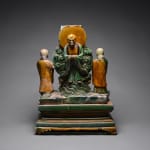Ming Glazed Terracotta Buddha with Two Attendants, 1368 CE to 1644 CE
Glazed Terracotta
62.2 x 43.2 cm
24 1/2 x 17 in
24 1/2 x 17 in
PH.0259
The current sculpture dates from the highly changeable and dynamic time of the Ming Dynasty, which ran from about 1368 to 1644 AD. This stone sculpture depicts the universal (Vairocana)...
The current sculpture dates from the highly changeable and dynamic time of the Ming Dynasty, which ran from about 1368 to 1644 AD. This stone sculpture depicts the universal (Vairocana) Buddha seated in padmasanam (lotus position) and the hands folded together, palms up, in a meditative position known as dhyana mudra. He is surrounded by two attendants resembling Buddhist monks. The Buddha wears a pantaloon-like garment overlain with a loose, flowing tunic. His face shows no signs of emotion, and has the appearance of one lost in deep meditation. His hair is represented by a series of spiraled curls. The earlobes are long and pendulous, the result of wearing heavy earrings during his princely youth, which also signify his abandonment of material possessions. Unlike some early Chinese Buddha images, such as the Sakyamuni Buddha, the Vairocana Buddha is shown in the standard meditating pose. This reflects the effort made by the Chinese to reinterpret the Buddhist religion, which by the time of the Tang Dynasty had become a central and important part of the Chinese culture. As Buddhism continued to thrive in China, the tenets of the faith and its iconography were continually reinterpreted by generations of religious philosophers and artisans. Soon, the traditional appearance of the Buddha as promulgated by Indian artisans had been changed almost beyond recognition, as this extremely fine figure testifies.



